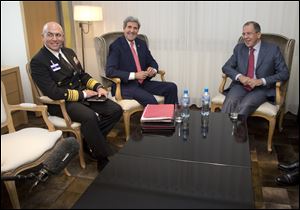
FEATURED EDITORIAL
Deal with Iran
Despite risks, the interim accord on Iran’s nuclear program is worth trying and preferable to a military strike
11/25/2013
From left, U.S. Navy Vice Admiral Kurt Tidd, U.S. Secretary of State John Kerry, and Russian foreign minister Sergei Lavrov meet before talks on Iran’s nuclear program in Geneva.
The agreement with Iran announced this week in Geneva will cap the expansion of its nuclear infrastructure and lengthen the time Tehran would need for a breakout attempt to build a bomb. Although the accord is freighted with risk, it is worthy as an interim step — and preferable to the military action that might otherwise have been deemed necessary.
The deal is intended to buy time for as much as a year of negotiations on a comprehensive settlement. The United States should not accept its terms over a longer period.
When all the provisions are implemented, the time Iran would theoretically need to produce enough highly enriched uranium for a bomb, which is now about one month, would extend by no more than a month or two. Or it could be as little as 24 days, in the estimation of unhappy Israeli officials.
U.S. officials say the sanctions relief granted Iran will be worth about $7 billion. That’s about six weeks of the oil revenue Iran is losing to sanctions.
The most welcome parts of the agreement will end Iran’s production of medium-enriched uranium, convert its stockpile into a less dangerous form, and stop the completion of a reactor that could have begun producing plutonium next year. More international inspections will add another measure of safety against an Iranian breakout.
The Obama Administration and its partners made several troubling concessions. The agreement states that Iran will retain an enrichment capacity in a comprehensive settlement. It also says the settlement will “have a specified long-term duration,” which suggests that restrictions on Iran’s nuclear work could eventually expire.
In addition to the financial relief, an important piece of the sanction architecture is being dismantled. Insurance measures that blocked most Iranian shipping will be relaxed.
The risks of the deal are consequently substantial. The first is a rift with Israel and with Saudi Arabia and other U.S. Arab allies. They objected to an interim arrangement that would leave Iran’s nuclear infrastructure mostly untouched, and they oppose allowing Iran permanent enrichment capacity.
The Israelis warn that once loosened, sanctions may crumble, leaving Iran with a rejuvenated economy and a breakout capacity. Whether those fears are realized will depend on the robustness of U.S. efforts to prevent nations such as India, China, and Japan from slackening in their adherence to strictures on Iranian oil sales.
Of still greater importance will be setting terms for a comprehensive settlement that will decisively diminish the risk of an Iranian nuclear breakout. If Iran is to get enrichment capacity, its number of centrifuges must be vastly reduced and several key facilities closed.
The restrictions should not have an expiration date. They will be needed as long as the current Iranian regime is in place. Whether that regime will accept such steps is very much open to doubt. A blistering recent attack on the United States and Israel by supreme leader Ayatollah Ali Khamenei ought to put to rest any notion that Iran and the West are headed toward a broader detente.
Congress played a vital role in bringing Iran to the bargaining table by passing tough sanctions, in some cases over the opposition of the Obama Administration. But lawmakers would be wise to refrain from imposing sanctions that take effect while negotiations proceed.
For now, the prudent course is to give diplomacy its chance.
— Washington Post